平成28年04月28日 木曜日号
“尚武(しょうぶ) 平成21年”
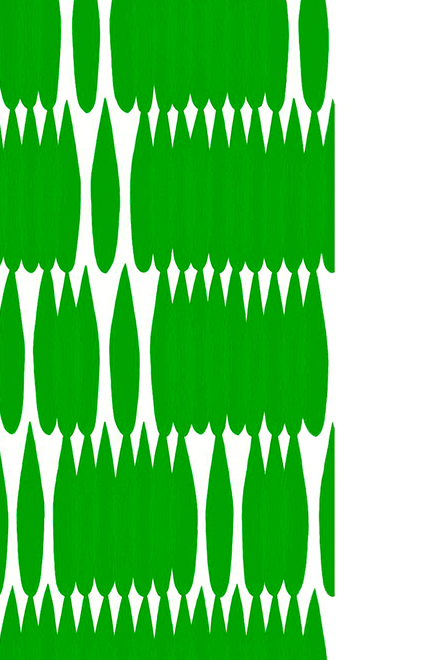
5月の端午の節句には菖蒲(しょうぶ)をお風呂に入れて、邪気を払い、
男の子が強くたくましく育つことを祈願する。
葉が刀に似ているところから「尚武(武をすすめる)」とも表される。
菖蒲の葉だけで模様を作るのは、むずかしい。シンプルに並べて
少しだけ変化をつけると、菖蒲が立ち並んでいる感じが出てきた。
端に白い空間を残したことで、間(ま)が出来て粋になった。
(脇阪 克二)
"Shōbu / Iris courage"(2009,by Katsuji Wakisaka)
Tango no Sekku in May 5, is known as Boy's day in Japan to wish boys healthy growth and courage.
A few blades of Iris are put into a bathtube when people take a bath on this day.
Iris, or Shōbu in Japanese, is linked to "尚武" (martial spirit), of which is pronounced in the same way, and as iris have a sword-like shape.
It is quiet difficult to create a pattern from iris leaves.
I keep aligning them while leaving white spaces irregularly.
The blank spaces provide the chic cream of this textile.
| English translation by LI XIAO XIAO |
"Shōbu / Militarisme"(2009, par Katsuji Wakisaka)
Le Jour des Garçons en Mars, les japonais mettent des Acores odorants dans le bain afin de se purifier et de prier pour que l'enfant grandisse avec force et robustesse.
Le terme “Shōbu” (Suivre la voie du sabre) vient de la ressemblance de cette fleur à une lame de Katana. Il est délicat de créer un motif à partir de feuilles d’Acores odorants.
En les alignant simplement, on a l'impression qu'ils se tiennent en rang, tel une armée.
La bordure blanche sur le côté droit crée une marge, dynamique et chic.
| Traduction française par Jean-Baptiste Fauvel Matsumoto |
"尚武"(2009, 脇阪 克二)
5月5日是日本的端午節,又稱男孩節。
這一天有用菖蒲泡澡辟邪,祈願家中男孩健康成長的習俗。
菖蒲葉形狀與劍相似,所以漢字也寫作「尚武」。
我將菖蒲葉竪著排佈,並將一端留白,
繪製成了這幅獨特的「尚武」印花。
| 中譯 : 李 瀟瀟 |
→こちらのテキスタイルデザイン商品
(Textile products with this pattern)
平成28年04月26日 火曜日号
“武者絵 平成28年”
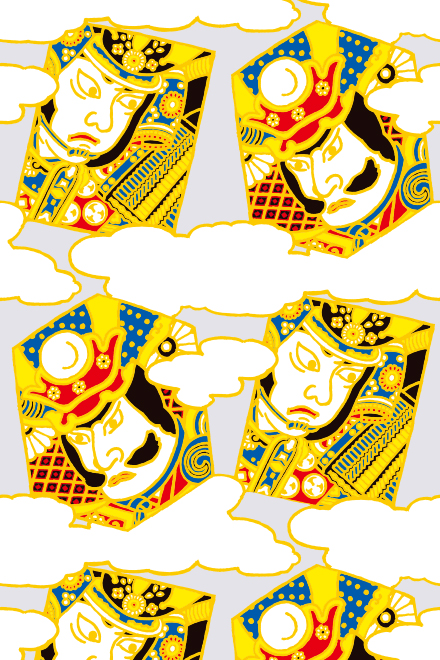

歴史、伝説、軍記物などに
登場する英雄、豪傑、武将や
その合戦の場面を描いたもの。
地方によっては5月の端午の節句に
武者絵のぼりを自宅の庭に立てる。
男児の誕生を祝い
無病息災、立身出世を願う。
(脇阪克二)
"Musha-e / Japanese warrior prints"(2016,by Katsuji Wakisaka)
Musha-e, or warrior prints, depicted armored samurai in battle scenes and other historical or legendary settings.
In some places, there is a custom of setting out Mushae-nobori (labrums with a warrior prints) in the garden, as the decoration of Tango-no-sekku on May 5 with the wish for the boy’s birth, sound growth and success in life.
| English translation by LI XIAO XIAO |
"Musha-e / Busshae Image de guerrier"(2016, par Katsuji Wakisaka)
Nous avons dessinés une scène de bataille dépeignant un héro, un grand homme et un général qui apparaîssent dans l’Histoire, les légendes et les chroniques de guerre.
Selon les régions, le Jour des Garçons, on installe dans le jardin un étendard de guerrier, pour fêter la naissance d'un garçon et lui souhaiter une bonne santé et une réussite sociale dans sa vie future.
| Traduction française par Jean-Baptiste Fauvel Matsumoto |
"武者绘"(2016, 胁阪 克二)
武者,即武士;
武士绘,指描绘历史、传说战争小说中武士着甲胄的姿态,或交战情景的浮世绘。
在日本一些地区,人们在端午节那天挂出印有武士绘的旗子,
用来庆祝家中男孩子的诞生,或祈愿他们的无病消灾,出人头地。
| 中译 : 李 瀟瀟 |
→こちらのテキスタイルデザイン商品
(Textile products with this pattern)
平成28年04月23日 土曜日号
“たけのこ 平成26年”
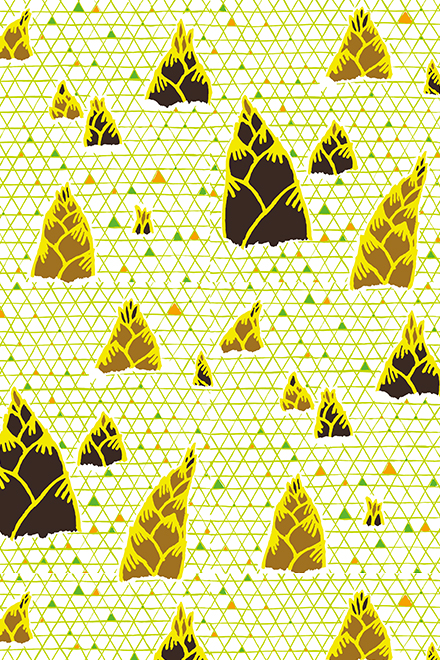
土の表面にたけのこが顔をのぞかせている。
ちょっとだけ芽を出しているものや
頭だけのぞかせているもの、ぐっと成長したものなど
背くらべをしているようでほほえましい。
そうして育ったたけのこの独特の味わいは
春の楽しみのひとつですね。
(脇阪 克二)
"Takenoko / Bamboo shoot"(2014,by Katsuji Wakisaka)
Takenoko(bamboo shoot) is breaking through the earth a bit.
Some of them put forth little buds,
some peek just their top, some are grown up vigorously,
as if they are showing which is the taller, which is the tallest. That is really charming.
The unique texture and refreshing taste of these takenoko grown up that way is one of our spring savors.
| English translation by Yuka Mamekoshi |
"Takenoko / Pousse de bambou"(2014, par Katsuji Wakisaka)
Les pousses de bambous pointent le bout de leur nez.
Certaines émergent à peine de terre, pendant que d'autres sortent à moitié, alors que les dernières sont déjà prêtes à la cueillette.
De ravissantes petites pousses, qui ont l'air de se comparer pour savoir qui est la plus grande. Déguster le goût si particulier des pousses de bambou est aussi un des attraits du printemps.
| Traduction française par Jean-Baptiste Fauvel Matsumoto |
"竹笋"(2014, 胁阪 克二)
竹笋们从土地里探出头,好奇地观望这个崭新的春日。
有的才露出了头顶,
有的奋力钻出了整颗头,
有的早已蹿出了半个身子――
小家伙们唯恐落后地比着高矮,谁也不肯认输。
好一幅让人忍俊的画面!
这些独具美味的竹笋唤醒了我们春的味蕾。
| 中译 : 李 瀟瀟 |
→こちらのテキスタイルデザイン商品
(Textile products with this pattern)
平成28年04月20日 水曜日号
“間がさね 平成18年”
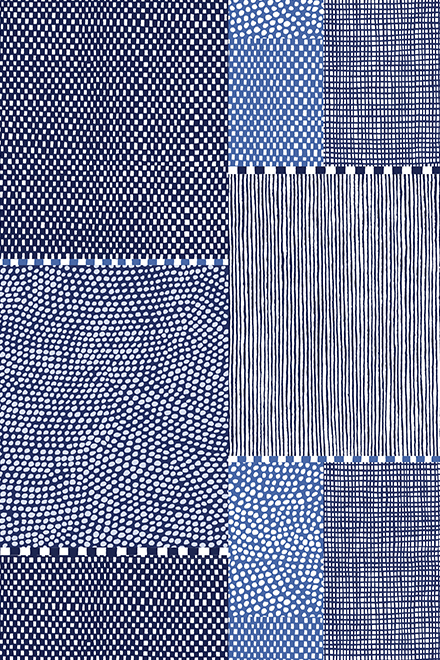
手さぐりで水玉を描きストライプを描いて空間を埋めていった。
外国で暮らしていると無意識のうちに
自分のアイデンティティーやルーツを考えている。
日本への想いもある。それが思いがけず出てきたようだ。
端切れになっても残しておきたいと思うものを
作りたいという強い想いがあった。
(脇阪 克二)
"Magasane / Dots and stripes"(2006,by Katsuji Wakisaka)
I just draw the water drops and stripes pattern randomly to made this "magasane".
“Magasane” is about identities and permanency.
As a matter of fact, living abroad makes me more aware of my identity.
I was keeping sight of who I am while homesickness strikes now and then.
It makes me being conscious of Japanese-style design.
I hope "magasane" is loved permanently even if it becomes a small piece fabric scraps.
| English translation by LI XIAO XIAO |
"Magasane"(2006, par Katsuji Wakisaka)
Magasane fait référence aux motifs de gouttes d'eau dessinées aléatoirement dans les bandes séparants les différents tissus.
En vivant à l'étranger, on réfléchit inconsciemment à notre identité et nos racines.
Évidemment au Japon. Et voici le motif qui en est ressorti, né d’un désir profond de fabriquer un motif original avec de vieilles chutes de tissus.
| Traduction française par Jean-Baptiste Fauvel Matsumoto |
"點線"(2006, 脇阪 克二)
我憑感覺畫一些圓點,再描一些線條,填滿紙面。
這些自然畫出的點和線中,
有我居住在外國時對自我存在感的理解,
以及對出生之地日本的思慕。
創作這副布料設計時,
我有一個强烈的念頭:
設計出即使被剪成了邊角料,也值得人品味珍惜的印花。
| 中譯 : 李 瀟瀟 |
→こちらのテキスタイルデザイン商品
(Textile products with this pattern)
平成28年04月16日 土曜日号
“おおいぬのふぐり 平成20年”
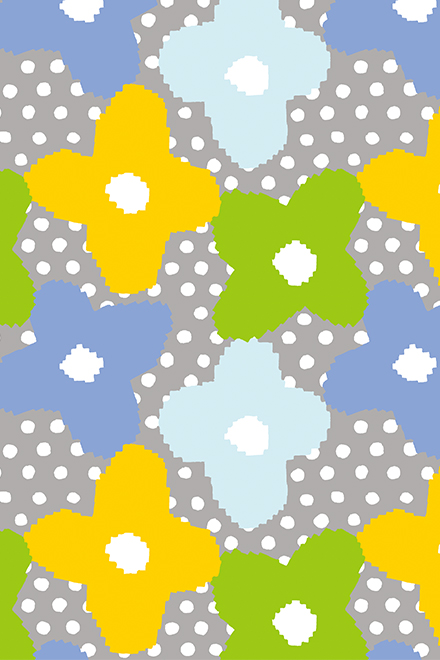
緑の中に小さく鮮やかな
おおいぬのふぐりの
青い花がびっしり並んでいる。
どういうわけか青空を見ている感じがする。
これを発見すると
春が来たなあとうれしくなる。
(脇阪 克二)
"Ōinunofuguri / Tiny blue flowers in spring"(2008,by Katsuji Wakisaka)
Small bright blue flowers,
Called Persian speedwell,
Rising from the green on this mild spring's day.
They grow densely around the countryside,
Make a carpet like the blue of sky.
Wherever they shine I'll be happy to wander,
Remembering the coming of spring in delights.
| English translation by LI XIAO XIAO |
"Ōinunofuguri / Véronique de Perse"(2008, par Katsuji Wakisaka)
De petites fleurs bleues éclatantes,
Appelées Véronique de Perse,
Abondent dans la verdure.
Curieusement, elles ne vont pas sans nous rappeler le ciel bleu.
Une découverte qui nous réjouit de la venue du printemps.
| Traduction française par Jean-Baptiste Fauvel Matsumoto |
"小野花"(2008, 脇阪 克二)
一片綠意中,綻放著一排藍色的小野花
它們的名字叫阿拉伯婆婆納
擡眼望去,那場景恍如一片鋪陳的青空
每當在路邊發現這些藍色精靈
都會真實感受到春之降臨
| 中譯 : 李 瀟瀟 |
→こちらのテキスタイルデザイン商品
(Textile products with this pattern)
平成28年04月13日 水曜日号
“さんさん 平成24年”
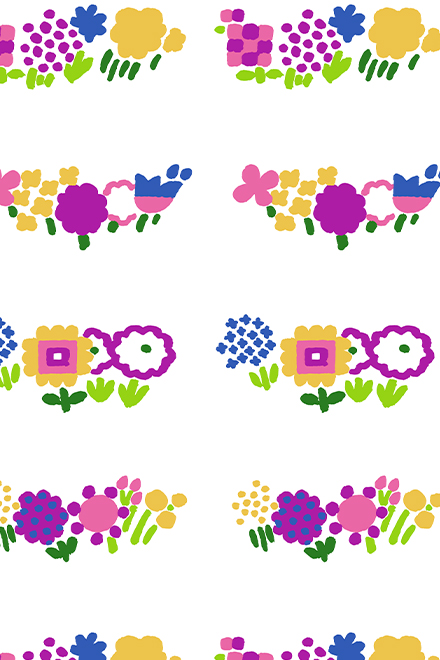
桜の季節が終り風薫るころ。
光り輝く太陽、真青な空にさわやかな大気。
さんさんとふりそそぐ陽を浴びて
ピンク、紫、黄、青と
とりどりの花が合唱している。
(脇阪 克二)
"Sansan / Radiance"(2012,by Katsuji Wakisaka)
Falling of cherry blossoms,
Blowing of fresh vernal breeze,
It's the bright serene April days,
Days of blue sky and mild air.
Little flowers in pink, purple, yellow, blue...
Singing in chorus in the brilliant sunshine
| English translation by LI XIAO XIAO |
"Sansan / Brillant "(2012, par Katsuji Wakisaka)
C'est l'heure des brises printanières successives aux cerisiers.
Un temps doux sous un soleil radieux et un ciel bleu.
Immaculées d'un soleil éclatant
Roses, violettes, jaunes, bleues,
Les innombrables fleurs chantent en cœur.
| Traduction française par Jean-Baptiste Fauvel Matsumoto |
"粲然"(2012, 胁阪 克二)
樱没,熏风微拂。
太阳好看地闪闪放光,
气爽,碧空无云。
春阳粲然倾泻,
花儿们沐浴在这和煦的光景里——
粉的,紫的,黄的,蓝的,
合唱一曲斑斓的小调。
| 中译 : 李 瀟瀟 |
→こちらのテキスタイルデザイン商品
(Textile products with this pattern)
平成28年04月09日 土曜日号
“ほほえみ 平成23年”
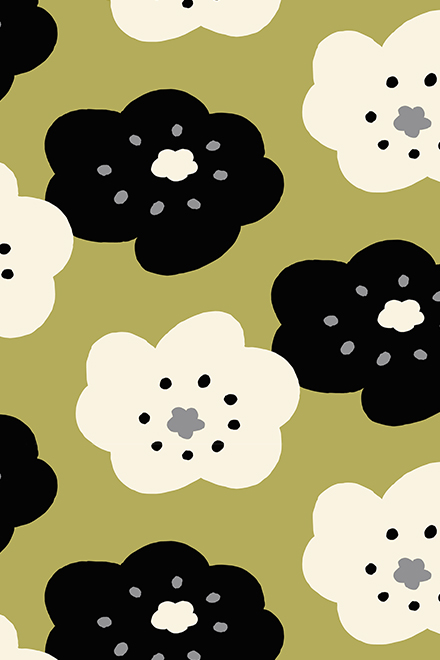
ほほえみは笑いと違って
その人の本当の気持を表していると思う。
包み込まれるような大きな
ほほえみに出会ったら
人はどんなに暖かい気持になるだろう。
(脇阪 克二)
"Hohoemi / Smile"(2011,by Katsuji Wakisaka)
Smile, being different laughing,
Shows the true feelings of a person.
Encounter with a radiant smile,
Bring you sunshine, and warm your heart.
| English translation by LI XIAO XIAO |
"Hohoemi / Un sourire"(2011, par Katsuji Wakisaka)
Je crois que le sourire, au contraire du rire, Reflète les véritables sentiments d'une personne.
Faire la rencontre fortuite d'un sourire radieux Réchauffe le cœur de n'importe quel individu.
| Traduction française par Jean-Baptiste Fauvel Matsumoto |
"微笑"(2011, 胁阪 克二)
微笑与大笑不同,
莞尔中饱含真意。
若偶能遇上一个粲然的微笑,
想必周身定会被融融暖意所包围吧。
| 中译 : 李 瀟瀟 |
→こちらのテキスタイルデザイン商品
(Textile products with this pattern)
平成28年04月06日 水曜日号
“さくらさくら 平成20年”
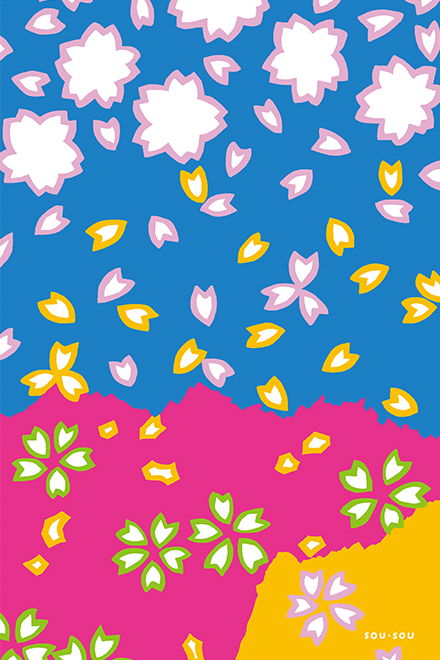
若いとき、桜は装飾的な感じがして好きな花ではなかった。
しかし年を重ねて京都へ戻ってきて
見る桜はこよなく美しい。
あと何回この花を見られるのだろうか。
桜を見ているこのときが何ものにも
かえがたいものに感じられてくる。
(脇阪 克二)
"Sakura, sakura"(2008,by Katsuji Wakisaka)
Back in the day when I was young,
I was not very fond of Sakura (cherry blossom) as I considered it an ornamental flower.
However, since my return to Kyoto after so many years, their beauty concerns me.
And I wonder,
Until when can I view them?
They blooming with pink and white perfections,
Giving me happiness, as no other flowers could bring.
| English translation by LI XIAO XIAO |
"Cerisiers, oh cerisiers!"(2008, par Katsuji Wakisaka)
Dans ma jeunesse, je n'aimais pas les fleurs de cerisiers que je considérais comme décoratives. Toutefois, depuis mon retour à Kyoto, Leur beauté m'interpelle. Jusqu'à quand pourrais-je les admirer? Je comprends à présent le caractère Inestimable de la saison des cerisiers.
| Traduction française par Jean-Baptiste Fauvel Matsumoto |
"樱复樱"(2008, 胁阪 克二)
年少时看樱,并无欣喜。
放眼望去尽是厚重的装饰感,感受不到它的自然美。
几十年后再回到京都赏樱,
忽而领悟到它的魅力。
年复一年樱复樱。
不知自己还能再赏几载樱。
唯能确信的是,如今赏樱,心境已与年少时不同。
如今它总能唤起我心底的一瞬,
难以取代而不可言喻的怦然。
| 中译 : 李 瀟瀟 |
→こちらのテキスタイルデザイン商品
(Textile products with this pattern)
平成28年04月02日 土曜日号
“爛漫 平成17年”
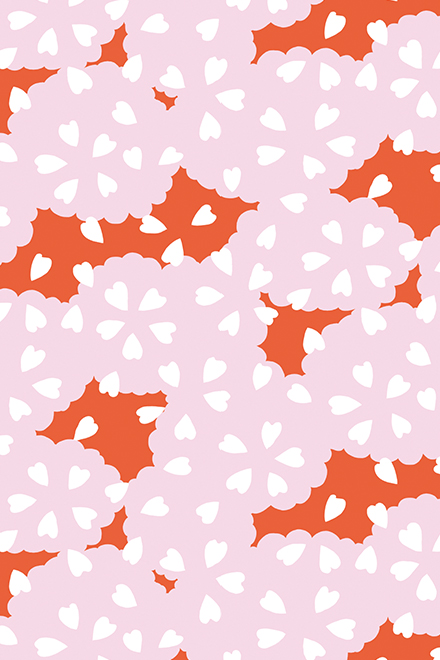
桜は日本の国花。
朝によく、夕によく、降ってよく、
嵐にも又あわれが深い。
満開のころは色彩的な喜びに満ち満ちており、
日常の世界を忘れて浮き浮きした
気持ちにいざなう。まさに春爛漫。
(脇阪 克二)
"Ranman / Full blossom"(2005,by Katsuji Wakisaka)
The cherry blossom or Sakura is considered the national flower of Japan.
They are burning bright,
From dawn to dusk, all day long.
The petal falls free, snowing down on your face.
Sakura blooms, blooms, to their fullest.
Then become a cherry blossom blizzard.
When they comes into full bloom,
Branches become soft petal clouds,
Colorfully painted, full of joy.
It feels like a dreamland, that make you forget reality.
Spring is in full bloom.
| English translation by LI XIAO XIAO |
"Ranman / Floraison Totale"(2005, par Katsuji Wakisaka)
Le cerisier est l’emblème du Japon.
Brilliant de mille feux, du matin jusqu'au soir,
qu'il pleuve ou qu'il vente.
En pleine floraison, ses branches se drapent
de nuages de pétales colorés, teintées de joie.
Il vous fait oublier la vie quotidienne
pour vous plonger dans un monde de merveille.
Le printemps dans toute sa splendeur.
| Traduction française par Jean-Baptiste Fauvel Matsumoto |
"烂漫"(2005, 胁阪 克二)
樱花是日本的国花。
晨开烂漫,
暮笑枝头,
零落也美。
繁华散落时狂舞一阵缱绻,
满开时节花繁艳丽,满树烂漫。
盛樱让人忘却日常的琐碎,
心中充溢着洋洋的欢悦。
樱烂漫,春烂漫。
| 中译 : 李 瀟瀟 |
→こちらのテキスタイルデザイン商品
(Textile products with this pattern)
平成28年03月30日 水曜日号
“桜づくし 平成23年”
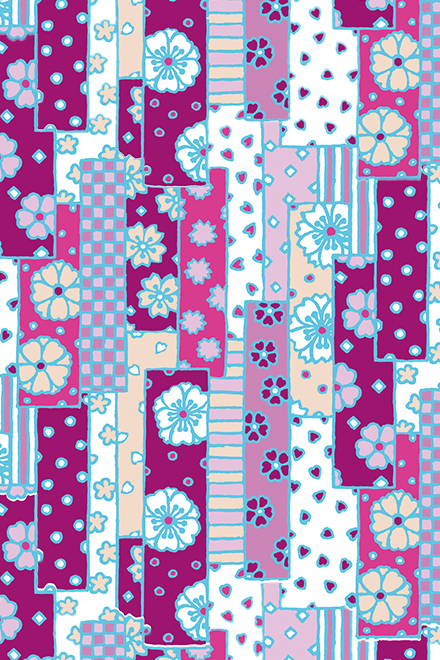
春になると日本各地が桜一色に包まれる。
艶やかで切なくて潔くて…。
何とも言えない感情を呼び起こす桜の花。
日本人は桜とともに情緒的なひとときを過ごす。
(脇阪 克二)
"Sakura zukushi / Sakura everywhere"(2011,by Katsuji Wakisaka)
In spring, cherry blossoms wake, paint Japan into sakura color.
Fascinatingly, touchingly, purely...
There are sakura everywhere.
These cherry blossoms always evoke indescribable feelings.
Alongside them, The Japanese spend a emotional moment in spring.
| English translation by LI XIAO XIAO |
"Sakura zukushi / Bouquet de cerisiers"(2011, par Katsuji Wakisaka)
Le printemps venu, le Japon se met aux couleurs des fleurs de cerisiers.
À la fois étincelants, poignants, purs…
Ces fleurs de cerisiers qui font naître en nous des sentiments indescriptibles.
A leurs côtés, les japonais passent un moment rempli d'émotions.
| Traduction française par Jean-Baptiste Fauvel Matsumoto |
"櫻花"(2011, 脇阪 克二)
每到春天,整個日本都被染成櫻花色
嬌艷、凄婉、純净的櫻花
喚起人們心中一股無法言喻的情緒
這個季節,日本人總與櫻花相伴
度過一段感性的春日時光
| 中譯 : 李 瀟瀟 |
→こちらのテキスタイルデザイン商品
(Textile products with this pattern)
平成28年03月29日 火曜日号
“大漁旗 平成28年”


漁船が大漁で帰港する際に
掲げる旗。
海上からでも目立つように
派手な色彩や大胆な構図で
描かれている。
「大漁」や「祝」の文字、
日の出や魚、恵比寿様や宝船
などの絵柄が多い。
人々の大漁への願いが生んだ
極彩色で力強い意匠だ。
(脇阪克二)
"Tairyō-bata / Fisherman’s flag"(2016,by Katsuji Wakisaka)
Tairyō-bata, literally translated as “big catch flag”, originally flown by boats that return to port with big catches.
They typically involving bright colors, so that it can be seen at sea.
The words "Big Fish " and "Celebration" in Chinese characters are written on them.
They also represent the pattern of sunrise, fish, Ebisu (God of development) and takarabune (treasure ship).
Tairyō-bata is a richly-colored and energetic design,
born of the strong hope that fishermen will be blessed with abundant catches.
| English translation by LI XIAO XIAO |
"Tairyō-bata / Drapeau de pêcheurs"(2016, par Katsuji Wakisaka)
Quand ils rentrent au port avec des grosses prises, les bateaux de pêches hissent un drapeau. Afin qu'il puisse être vu en pleine mer, Les dessins sont énormes et très colorés. Ils représentent souvent le levé du soleil, Des poissons, des bateaux-trésors ou encore La divinité de la pêche et du commerce Ebisu. Les mots “Gros Poissons” ou “Célébration” y sont parfois écrits dessus. Il s'agit d'une conception colorée et énergique, Née du désir de bonnes pêches des locaux.
| Traduction française par Jean-Baptiste Fauvel Matsumoto |
"大渔旗"(2016, 胁阪 克二)
大渔旗是渔船丰收归港时扬起的彩旗。
为了在茫茫大海中显得耀眼醒目,
大渔旗着色鲜艳,构图大胆。
旗面通常绘有“大渔”“祝”等字样,
以及旭日、鱼、惠比寿神、宝船等图案。
大渔旗满载着人们祈祷渔业丰收的愿景,
是具有强烈的色彩感和力量感的日本传统设计纹样。
| 中译 : 李 瀟瀟 |
→こちらのテキスタイルデザイン商品
(Textile products with this pattern)
平成28年03月26日 土曜日号
“ひとひら 平成21年”
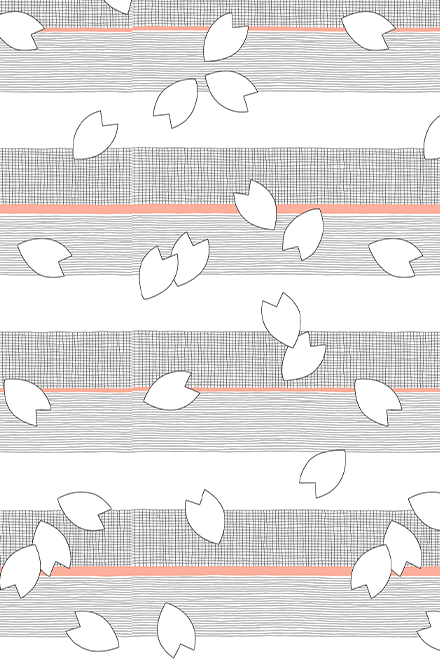
天に向かって伸びた大木の山桜。
ひとひら、ひとひら、花びらがこぼれ落ちる。
その下にたたずんでいると、夢なのか現実なのか、
定かではなくなってくる。日本人は、散る桜を見て
生きることのはかなさ、今生きていることの
尊さを歌に詠み、絵に表し、涙してきた。
(脇阪克二)
"Hitohira / Falling sakura petals"(2009,by Katsuji Wakisaka)
From the tall, tall wild cherry trees,
The sakura(cherry blossom) petals begin to wilt,
Slowly falls from the trees one by one.
Standing under the branches, it is hard to distinguish a dream or reality.
In Japan, the falling sakura petals, have been utilized often in poems, songs, paintings.
They represent the ephemeral nature of life, and the importance of living in the present.
| English translation by LI XIAO XIAO |
"Pétales de fleurs de cerisiers"(2009, par Katsuji Wakisaka)
Les grands troncs des cerisiers sauvages se prolongent vers les cieux.
Les pétales de leurs fleurs tombent une a une.
Assis sous ces branches, s’agit-il d’un rêve ou bien de la réalité,
l’incertitude nous envahit. Lorsqu’ils admirent les pétales de cerisiers,
qui représentent la fugacité de la vie et l’importance du vivant,
interprétés dans une chanson ou représentés dans une peinture,
les Japonais ont les larmes aux yeux.
| Traduction française par Jean-Baptiste Fauvel Matsumoto |
"一片一片"(2009, 胁阪 克二)
笔直向上生长的一大株山樱树。
一片一片,一片一片,
樱瓣飘零,纷落。
人伫立在景中片刻,
已分不清梦境与现实。
日本人古来将落樱入画,入诗,
咏叹生命的无常,稍纵即逝的时光,
以及活在当下的可贵。
人看着这一片一片,一片一片。
不禁感慨,不禁含泪。
| 中译 : 李 瀟瀟 |
→こちらのテキスタイルデザイン商品
(Textile products with this pattern)
平成28年03月23日 水曜日号
“三色菫 昭和58年”
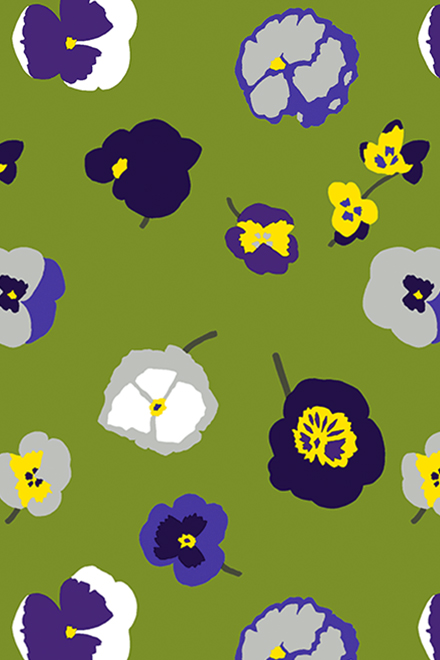
深く神秘的な紫、鮮やかな黄色。
ビロードのような質感。
不思議な花びらの形。
他の花にはない強烈な個性を持った花、三色菫。
かわいいだけではなくどこか悪魔的な魅力を
秘めて迫ってくるものがある。
(脇阪 克二)
"Shanshoku sumire / Violet violas"(1983,by Katsuji Wakisaka)
A mysterious purple, with a bright yellow.
A velour texture, and singularly shaped petals.
The Shanshoku sumire (Violet violas),
A flower with an intense personality.
She is not only beautiful,
But also hides within a devilish charm.
| English translation by LI XIAO XIAO |
"Shanshoku sumire / La pensée sauvage"(1983, par Katsuji Wakisaka)
Un violet profond etmystérieux, un jaune
Une texture de velours.
Un pétale aux formes singulières.
La pensée sauvage, une fleur sans égale à la personnalité intense.
Elle n'est pas seulement belle,
Elle cache en son sein un charme diabolique.
| Traduction française par Jean-Baptiste Fauvel Matsumoto |
"三色堇"(1983, 胁阪 克二)
神秘的紫,鲜亮的黄。
天鹅绒般的质感,
不可捉摸的花瓣轮廓。
鲜见的强烈的个性是你,
三色堇。
乖巧中藏匿着小恶魔般的魅惑。
欲盖弥彰是你,
三色堇。
| 中译 : 李 瀟瀟 |
→こちらのテキスタイルデザイン商品
(Textile products with this pattern)
平成28年03月19日 土曜日号
“春分 平成25年”
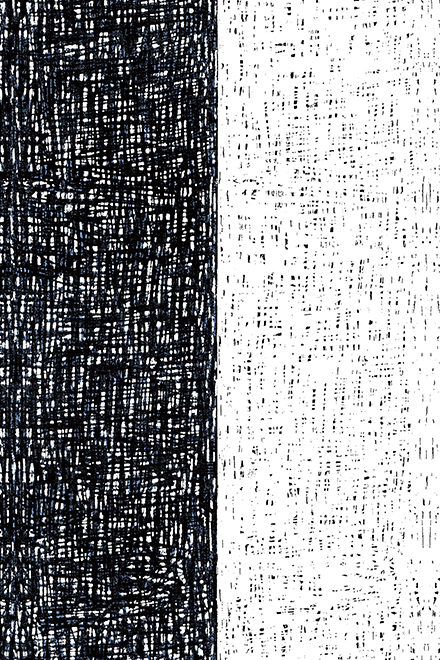
白と黒が半分ずつ
光と闇が半分ずつ
昼と夜が半分ずつ
春分の日はそういう日です。
そして、いよいよ本格的な春が
来つつあると実感できる日でもあります。
(脇阪 克二)
"Shunbun"(2013,by Katsuji Wakisaka)
half white and half black
half light and half dark
half day and half night
Shunbun, the vernal equinox day, is the day like that.
And you can feel the spring has finally come on that day as well
| English translation by Yuka Mamekoshi |
"Équinoxe de printemps"(2013, par Katsuji Wakisaka)
À moitié noir et blanc
À moitié lumière et ténèbres
À moitié jour et nuit
Voilà ce qu'est l'équinoxe de Printemps.
C'est également le jour où on ressent enfin son arrivée incontestable.
| Traduction française par Jean-Baptiste Fauvel Matsumoto |
"春分"(2013, 脇阪 克二)
一半白,一半黑;
一半光,一半影;
一半晝,一半夜。
是日春分。
陽和漸起,
春日已走到了跟前。
| 中譯 : 李 瀟瀟 |
→こちらのテキスタイルデザイン商品
(Textile products with this pattern)
平成28年03月16日 水曜日号
“清明 平成25年”
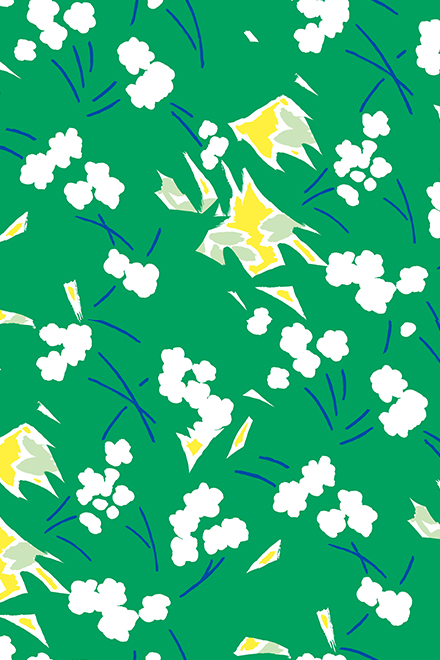
春先のさわやかな大気の中、花が咲きはじめ
万物が清らかで生き生きしはじめるころ。
入学や卒業、就職、引越しといったころでもある。
出会いや別れ、旅立ちなど
人生のドラマが待っている季節でもある。
(脇阪 克二)
"Seimei / Clear and bright spring"(2013,by Katsuji Wakisaka)
Spring in the air,
Refreshing and clear.
Spring on the ground,
Bright and vivid.
Flowers begin to bloom,
All living things recover their vitality.
It’s the season of graduation, beginning of term, start of work and removal.
And also, an eventful period marked by encounters, separations or travel.
| English translation by LI XIAO XIAO |
"Quingming / Clareté et Luminosité"(2013, par Katsuji Wakisaka)
Dans l'air frais printanier, les fleurs commencent à éclore
Et tous les êtres vivants recouvrent leur vitalité.
C'est également la rentrée des classes, le début de l'année pour les entreprises ainsi que la saison des déménagements.
Une période riche en évènements, marquée par des rencontres, des séparations ou encore des voyages.
| Traduction française par Jean-Baptiste Fauvel Matsumoto |
"清明"(2013, 脇阪 克二)
早春空氣澄明,花始笑。
萬物蘇醒,大自然一派明媚盎然。
入學,畢業,就職,搬家,
或相遇,或別離,或踏上一段旅途。
我們總在這個季節迎來人生的下一幕劇。
|中譯 : 李 瀟瀟 |
→こちらのテキスタイルデザイン商品
(Textile products with this pattern)
平成28年03月12日 土曜日号
“しあわせ 平成21年”
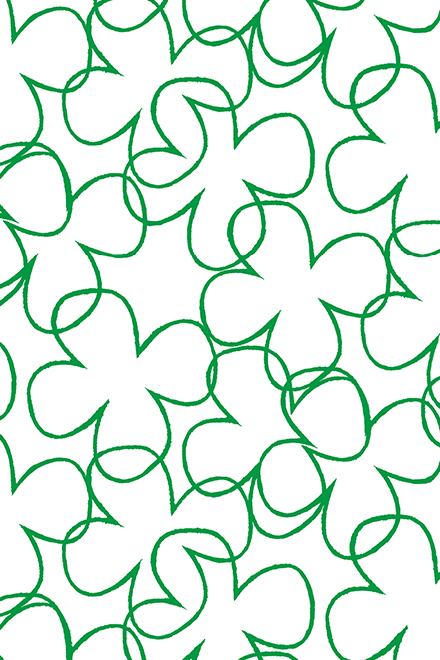
5月頃から野原に姿をあわらす白詰草。
普通は三枚の葉をつけるが、中には四枚の葉もあって、
それを見つけるとしあわせになれるという言い伝えがある。
僕が子どものころ、女の子は白詰草を摘み、
その茎を編んで王冠や首飾りにして遊んでいた。
昔の子ども達は豊かな時間をすごしていたと思う。
(脇阪克二)
"Shiawase / Happiness"(2009,by Katsuji Wakisaka)
White clover dotted the field around May.
Commonly, they has three leaves.
But 4-leaf clover is, as it were, a rare variation.
According to tradition, finding a 4-leaf clover promise happiness.
In my childhood, the girls picked clover from spring field,
twined them into wreaths or head wear, had such fun.
Children once lived more substantially, I suppose.
| English translation by LI XIAO XIAO |
"Shiawase / Bonheur"(2009, par Katsuji Wakisaka)
Au mois de Mai apparaîssent dans les vergers les trèfles blancs.
En temps normal, ils ne comprennent que trois feuilles mais certains en compte quatre.
Il existe un dicton qui avance que si vous en trouvez un à quatre feuilles, vous trouverez également le bonheur.
Dans mon enfance, les jeunes filles s'amusaient à les cueillir pour les tresser en couronne ou en collier.
À mon avis, les enfants d'autrefois vivaient de façon plus substantielle.
| Traduction française par Jean-Baptiste Fauvel Matsumoto |
"幸运草"(2009, 胁阪 克二)
素洁的幸运草纷繁轻缀在五月的原野,
三叶的一万株,四叶的一株。
传说找到这罕见的一株四叶草会得到幸福。
孩提时,女孩儿们摘来幸运草编成花环戴在头上。
从前的孩子有着雀跃馨香,充实快乐的童年。
| 中译 : 李 瀟瀟 |
→こちらのテキスタイルデザイン商品
(Textile products with this pattern)
平成28年03月09日 水曜日号
“松は松らしく 平成16年”
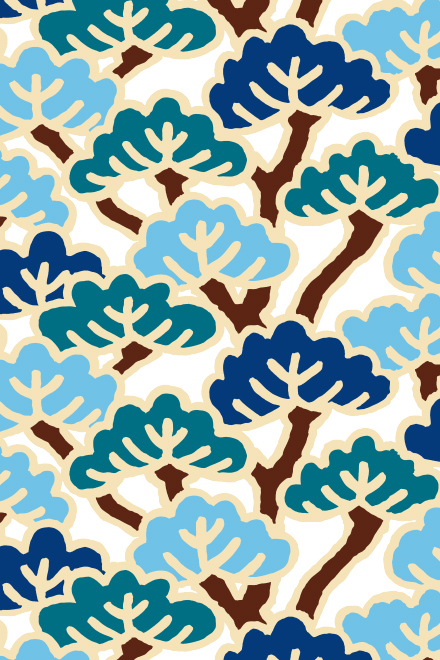
松には松の美しさがあり、
竹には竹の美しさがある。
松に竹の美を求めても無理である。
人も同じで、その人その人の
長所を生かすようにすればよい。
自然に、無心に、あるがままの姿で
生きていくことが出来れば、
それが最も美しいことなのだろう。
(脇阪 克二)
"Matsu wa matsu rashiku / Natural pine beauty"(2004,by Katsuji Wakisaka)
The pine has its own beauty.
So does the bamboo.
The beauty of the pine cannot be found in bamboo.
It is the same with human beings.
Everyone is beautiful in their own way.
To live brilliantly is to live naturally and innocently by staying true to yourself, isn't it?
| English translation by LI XIAO XIAO |
"Matsu wa matsu rashiku / Tel un pin"(2004, par Katsuji Wakisaka)
Le pin a sa beauté propre, Tout comme le bambou. La beauté du pin ne peut être retrouvée dans le bambou. Il en est de même avec les êtres humains, Chacun a ses propres qualités Qu'il convient de développer et polir. Le plus bel acte au monde serait De vivre naturellement et innocemment En restant fidèle à soi-même.
| Traduction française par Jean-Baptiste Fauvel Matsumoto |
"松之態"(2004, 脇阪 克二)
松有松的蒼勁
竹有竹的俊秀
你無法在松中找到竹的美
也無法在竹中尋到松之態
人也是如此
每個人都有自己獨特的姿態
發掘自身與生俱來的閃光點
自善自美,率性而活的人是最美
| 中譯 : 李 瀟瀟 |
→こちらのテキスタイルデザイン商品
(Textile products with this pattern)
平成28年03月05日 土曜日号
“うらら 平成24年”
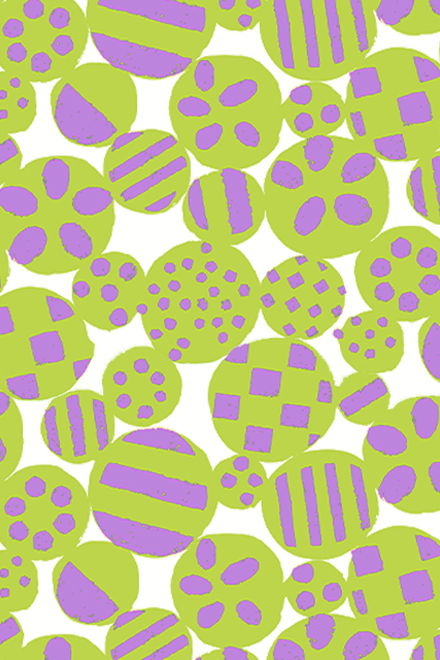
早春のやわらかな緑の中に
丸いかわいいつぼみが
ふくらみを増してくる。
寒さの中、少しずつ春の暖かさが
しのびこんでくる。
つぼみが花開き、うららかな春は
もうそこまで来ている。
(脇阪 克二)
"Urara / Spring buds"(2012,by Katsuji Wakisaka)
Little buds,
small and round,
keep swelling in the early spring green.
Warm sunshine dispersing the winter chill all around.
Little buds cheerfully burst,
Ring a ding dong!
Here comes spring!
Bright and promising.
| English translation by LI XIAO XIAO |
"Urara / Bourgeons"(2012, par Katsuji Wakisaka)
Dans la verdure pale d'un printemps précoce, De jolis petits bourgeons tout ronds Grossissent à vue d'œil. La douceur printanière prend peu à peu Le pas sur le froid hivernal. Les bourgeons fleurissent enfin. Le printemps, si clair et si lumineux, Est déjà si avancé dans l'année.
| Traduction française par Jean-Baptiste Fauvel Matsumoto |
"明麗"(2012, 脇阪 克二)
在早春柔軟的層層嫩綠裏,
藏著繁星般的細小花蕾,
圓溜溜,明燦燦。
春意漸暖,大地複蘇,
小家夥們含苞初綻,
笑盈盈,明燦燦。
原來明麗的春光已來到面前。
| 譯 : 李 瀟瀟 |
→こちらのテキスタイルデザイン商品
(Textile products with this pattern)
平成28年03月02日 水曜日号
“ひなまつり 平成21年”

ひなまつりと言えば、緋毛氈(ひもうせん)の上におひなさま。
でも菱餅も素敵なもの。
菱形をした、紅、白、緑の餅が
三段重ねになっていてかわいい。
その三色の菱形を並べていって
桃の節句のお祝いに。
(脇阪克二)
"Hinamatsuri / Doll's festival"(2009,by Katsuji Wakisaka)
The mention of Hinamatsuri, or Doll Festival, we think of hina-ningyō (Hina dolls).
They are usually displayed on a red carpet called "himōsen".
Hishimochi, a lovely, diamond-shaped rice cake, is served on the Hinamatsuri.
It consists of 3 layers with red(pink), white and green.
As Hinamatsuri also known as Momo no Sekku(Peach flower festival),
Hishimochi is a symbolic confection for Momo no Sekku celebration as well.
| English translation by LI XIAO XIAO |
"Hinamatsuri / La fête des filles"(2009, par Katsuji Wakisaka)
La fête des filles, c'est avant tout ces poupées traditionnelles Hina Ningyō exposées sur un tapis rouge surélevé Himōsen.
Le Hishimochi, gâteau de riz en forme de losange servi lors du Hinamatsuri, n'est pas en reste. Ce joli petit met est composé de trois étages rouges, blancs et verts.
Ces trois losanges colorés célèbrent le Momo no Sekku (Festival des pêchers), autre nom donné à la fête des filles.
| Traduction française par Jean-Baptiste Fauvel Matsumoto |
"女兒節"(2009, 脇阪 克二)
一提到日本女兒節,
總會聯想到擺飾在紅毯上的人偶。
但在我看來,女兒節食俗之一的“三色菱餅”同樣魅力十足。
三色菱餅是由粉色、白色、綠色層層相叠的鑽石形狀的年糕。
我把這幅可愛的菱餅獻給女兒節(桃花節)。
| 中譯 : 李 瀟瀟 |
→こちらのテキスタイルデザイン商品
(Textile products with this pattern)
平成28年02月27日 土曜日号
“菊 平成16年”
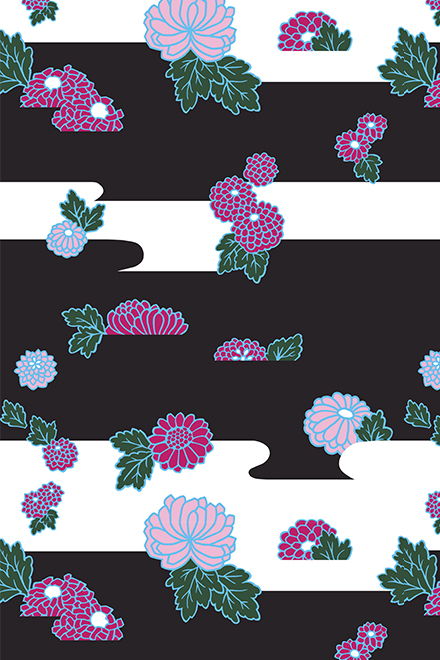
パリ滞在中に今までさけてきた
日本的なもののよさを意識しはじめる。
帰国後、和菓子や干菓子の菊をモチーフに
思いをこめてデザインした。
日本的な印象を強調しようと
ハーモニーよりコントラストを重視、
黒い雲で緊張感を。
(脇阪 克二)
"KIKU / Chrysanthemum"(2004,by Katsuji Wakisaka)
During my stay in Paris, I began to be conscious of the unique charm of Japanese-style things.
After my return back to Japan, I put my heart into designing with the motif of chrysanthemum inspired by wagashi.
Since I’m trying to emphasize Japanese characteristics,
I regard construction as more important than harmony.
And in this KIKU (Chrysanthemum), I used the black cloud to give a sensation of tension.
| English translation by LI XIAO XIAO |
"KIKU / Chrysanthème"(2004, par Katsuji Wakisaka)
Depuis mon passage à Paris, je commence à prendre conscience
de la beauté des objets japonais que je préférais jusqu'alors ignorer.
Après mon retour au Japon, j'ai mis tous mes efforts à la réalisation
de gâteaux traditionnels et de constructions sèches en forme de chrysanthèmes.
Un regard porté vers le contraste plutôt que l'harmonie,
tel ce nuage noir créant cette sensation d’inconfort…
| Traduction française par Jean-Baptiste Fauvel Matsumoto |
"菊"(2004, 脇阪 克二)
在巴黎生活期間,我才突然意識到日本文化的真諦。
回國後,我開始嘗試將和菓子中的「菊」設計爲染織紋樣。
爲了强調日式審美的視覺印象,
在設計這款「菊」時,主要偏重强烈的明暗色彩對比,
並用黑色的雲營造出畫面的緊張感。
| 中譯 : 李 瀟瀟 |
→こちらのテキスタイルデザイン商品
(Textile products with this pattern)







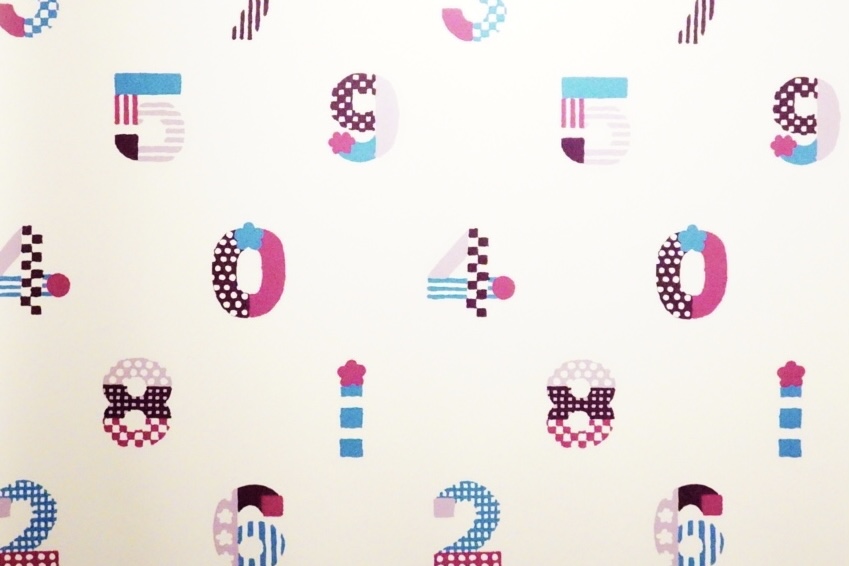
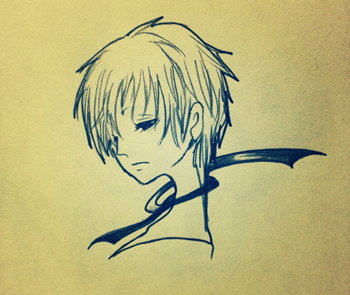
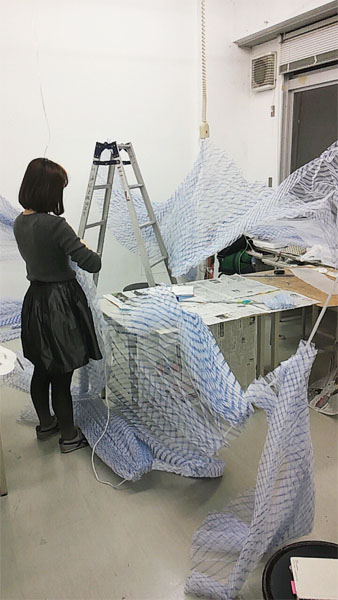
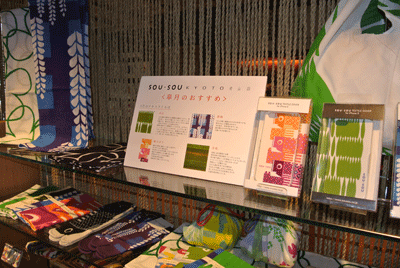
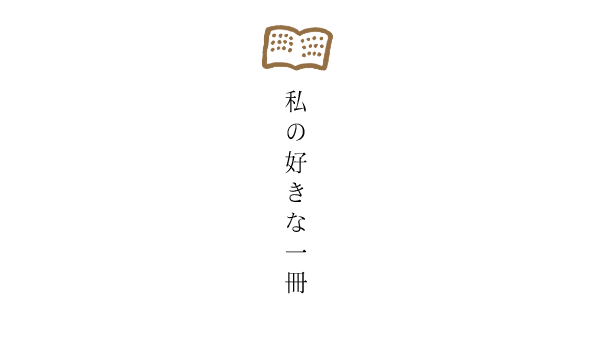
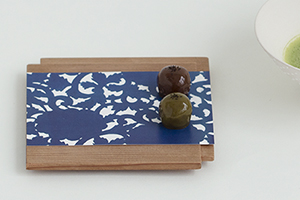
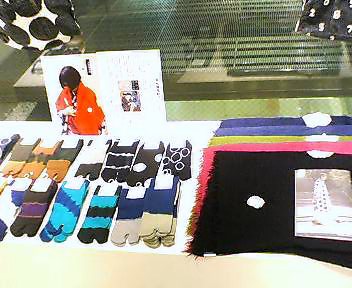

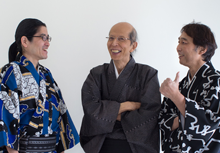

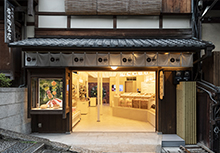

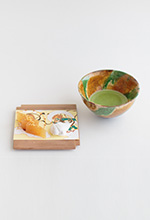
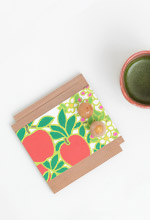
 お問い合わせ窓口
お問い合わせ窓口